by Melanie Taylor | Oct 31, 2017
From candy to pumpkins to the costumes, Halloween is a fun-filled time for kids and adults alike. However, it can pose dangers. To help make this year’s trick-or-treat a safe and fun time, follow these simple safety tips complied by the American Academy of Pediatrics.
CREATIVE COSTUMES:
Plan costumes that are bright and reflective. Make sure that shoes fit well and that costumes are short enough to prevent tripping, entanglement or contact with flames.
Consider adding reflective tape or striping to costumes and trick-or-treat bags for greater visibility.
Because masks can limit or block eyesight, consider non-toxic makeup and decorative hats as safer alternatives. Hats should fit properly to prevent them from sliding over eyes. The makeup should be tested ahead of time on a small patch of skin to ensure there are no unpleasant allergies on the big night.
When shopping for costumes, wigs and accessories look for and purchase those with a label clearly indicating they are “flame resistant”.
If a sword, cane, or stick is a part of your child’s costume, make sure it is not sharp or long. A child may be easily hurt by the accessories if he/she stumbles or trips.
Do not use decorative contact lenses without an eye examination and a prescription from an eye care professional. While the packaging on decorative lenses will often make claims such as “one size fits all,” or “no need to see an eye specialist,” obtaining decorative contact lenses without a prescription is both dangerous and illegal. This can cause pain, inflammation, and serious eye disorders and infections, which may lead to permanent vision loss.
Review with children how to call 911 if they ever have an emergency or become lost.
PUMPKIN CARVING TIME:
Small children should never carve pumpkins. Children can draw a face with markers. Then adults can do the cutting.
Consider using a flashlight or glow stick instead of a candle to light your pumpkin. If you do use a candle, a votive candle is safest.
Candlelit pumpkins should be placed on a sturdy table, away from curtains and other flammable objects, and not on a porch or any path where visitors may pass close by. They should never be left unattended.
HOME SAFETY:
To keep homes safe for visiting trick-or-treaters, parents should remove from the porch and front yard anything a child could trip over such as garden hoses, toys, bikes and lawn decorations.
Adults should check outdoor lights and replace burned-out bulbs.
Wet leaves and debris should be swept from sidewalks and steps.
Restrain pets so they do not jump on or bite a trick-or-treater.
TRICK-OR-TREAT TIME:
A responsible adult should always accompany young children during their neighborhood trick-or-treating.
Obtain flashlights with fresh batteries for all children and adults.
If your older children are going alone, plan and review the route that is acceptable to you. Agree on a specific time when they should return home.
Only go to homes with a porch light on and never enter a home or car for a treat.
Because pedestrian injuries are the most common injuries to children on Halloween, remind Trick-or-Treaters to:
- Stay in a group and communicate where they will be going.
- Remember reflective tape for costumes and trick-or-treat bags.
- Carry a cellphone for quick communication.
- Remain on well-lit streets and always use the sidewalk.
- If no sidewalk is available, walk at the far edge of the roadway facing traffic.
- Never cut across yards or use alleys.
- Only cross the street as a group in established crosswalks (as recognized by local custom). Never cross between parked cars or out driveways.
- Do not assume the right of way. Motorists may have a hard time seeing Trick-or-Treaters.
- Just because one car stops, does not mean others will!
- Law enforcement authorities should be notified immediately of any suspicious or unlawful activity
HEALTHY HALLOWEEN TIPS:
A good, healthy dinner prior to parties and trick-or-treating will discourage children from filling up on Halloween treats.
Consider purchasing non-food treats for those who visit your home, such as coloring books, stickers, or pens and pencils.
Wait until children are home to sort and check treats. Though tampering is rare, a responsible adult should closely examine all treats and throw away any spoiled, unwrapped or suspicious items.
Try to ration treats for the days and weeks following Halloween to prevent overindulging, which will lead to a stomachache and ruin the night’s fun.
Make sure the Halloween night is fun and safe with the suggested tips above. These tips will help guarantee you all a ghoulishly good time.
Source: American Academy of Pediatrics
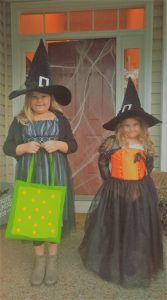
Happy Halloween!
by Heather Kent | Oct 6, 2017
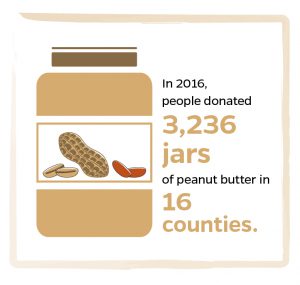 Did you know that the Saturday of National 4-H Week is the 4-H Day of Service? 4-H Clubs across the nation will be celebrating National 4-H Week with “hands to larger service.” Service is a huge part of the 4-H program (one of the “H”s”) and also helps teach youth compassion for others. Service is also a requirement in order to maintain a 4-H club charter.
Did you know that the Saturday of National 4-H Week is the 4-H Day of Service? 4-H Clubs across the nation will be celebrating National 4-H Week with “hands to larger service.” Service is a huge part of the 4-H program (one of the “H”s”) and also helps teach youth compassion for others. Service is also a requirement in order to maintain a 4-H club charter.
Younger youth typically start out with community service. Community service is volunteering in your community. This is usually done through food drives, such as the Peanut Butter Challenge, or volunteering at an animal shelter, collecting coats or blankets for those in need, or a toy drive during the holidays. If you are looking for an easy but impactful service project for your club, I would encourage you to participate in the Peanut Butter Challenge. Each county in the panhandle is collecting jars of peanut butter to donate to local food pantries. The Florida Peanut Producers will match the donation of the county that collects the most peanut butter. Contact your local UF IFAS County Extension Office for more info or refer to this flyer.
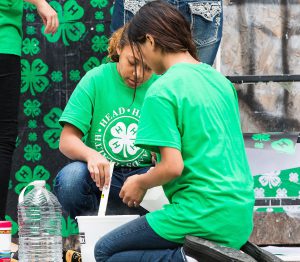 Older youth are encouraged to move from community service to service learning. What’s the difference? Service-Learning is more than a “one-shot deal.” Instead of spending a day or few hours helping someone, youth identify a need, and develop a strategy to address it. It also incorporates reflection and celebration. Service-Learning projects take community service to the next level by emphasizing both service and learning and is more meaningful for older youth.
Older youth are encouraged to move from community service to service learning. What’s the difference? Service-Learning is more than a “one-shot deal.” Instead of spending a day or few hours helping someone, youth identify a need, and develop a strategy to address it. It also incorporates reflection and celebration. Service-Learning projects take community service to the next level by emphasizing both service and learning and is more meaningful for older youth.
Example:
- Community Service – Youth prepare and serve a meal at a local homeless shelter.
- Service-Learning – Youth research homelessness in their community and contact local homeless shelters to learn about the types of services they provide. Youth then decide together on a service project that will support this community need. After planning and completing the service project, youth reflect upon both the Service-Learning process and the service project.
Did you know Florida 4-H has a state service project selected by our youth executive board? Each year the State Project Committee of the Executive Board recommends activities in which 4-Her’s can participate that will carry out the state wide community service project of the Florida 4-H Council. This year, the committee decided that the theme for 2017-2019 will be “Living In Florida’s Environment (LIFE)”. This project is focused on creating a greener tomorrow by hosting beach cleanups, planting trees, and participating in citizen science activities.
Youth can receive recognition for their service efforts at 4-H University. It is also a requirement for the District 4-H Spirit Stick Awards. The State Project Committee encourages all youth to participate in at least one state project that is associated with LIFE. The committee would also like to recognize the youth that do participate in these projects. Once a project is completed, please record it on the project report-back sheet found in the tool kit below. These record sheets will need to be submitted to Grace Carter by July 3, 2018. The committee would appreciate if pictures were included in these reports.
The report form can be found in the LIFE Service Project Guide.
Project Achievement
Bronze: Youth who complete 1 service project will receive a bronze certificate of completion.
Silver: Youth who complete 2 service projects will receive a silver certificate of completion.
Gold: Youth who complete 3-4 service projects will receive a gold certificate of completion
and will also receive recognition at 4-H University 2018.
Emerald: Youth who complete 5 or more service projects will receive an emerald certificate
of completion and will also receive recognition at 4-H University 2018.
by amgranger | Oct 5, 2017
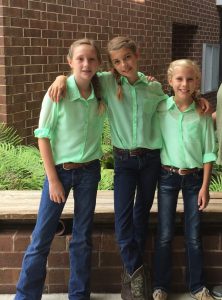 From its beginning, the 4-H program has used a system of clubs and competitive activities to promote learning and the development of specific skills of 4-H members (Ladewig & Thomas, 1987). Sometimes competition is viewed negatively. Florida 4-H does not believe that competition is beneficial for youth under the age of eight, but for older youth, competition can help promote the development of life skills. When you break it down, competition is simply the process of comparing skills (Midura & Glover, 1999). Competition provides opportunities for youth to master and demonstrate life skills that can be used in the real world. For example, livestock judging participants learn more than animal science- they learn about the ethical treatment of animals, how to communicate and critical thinking.
From its beginning, the 4-H program has used a system of clubs and competitive activities to promote learning and the development of specific skills of 4-H members (Ladewig & Thomas, 1987). Sometimes competition is viewed negatively. Florida 4-H does not believe that competition is beneficial for youth under the age of eight, but for older youth, competition can help promote the development of life skills. When you break it down, competition is simply the process of comparing skills (Midura & Glover, 1999). Competition provides opportunities for youth to master and demonstrate life skills that can be used in the real world. For example, livestock judging participants learn more than animal science- they learn about the ethical treatment of animals, how to communicate and critical thinking.
Weber and McCullers (1986) stated that “young men and women who traditionally attain the highest levels of achievement in the 4-H program are typically very successful ‘in other aspects of life as well.” Other studies have also shown that competition helps to decrease juvenile delinquency, foster responsible social behavior, stimulate creativity, motivate young people to set goals, prepare them for the competitive world and gain important life skills.
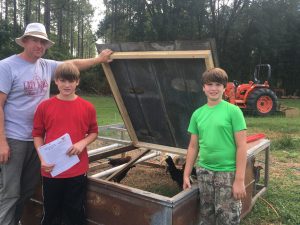 Competitions involving judging are beneficial educational tools used to prepare youth for the workforce, regardless of their chosen careers. Former participants have learned to become team players, which is essential to their success and efficiency in the workplace. Teambuilding skills are an essential element of success at any age.
Competitions involving judging are beneficial educational tools used to prepare youth for the workforce, regardless of their chosen careers. Former participants have learned to become team players, which is essential to their success and efficiency in the workplace. Teambuilding skills are an essential element of success at any age.
In a 2003 study conducted by the University of Idaho to determine development of beneficial life skills associated with past participants in 4-H Livestock and Horse Judging programs, over 97% of the judging alumni indicated that the Idaho 4-H judging experience positively influenced their personal success. The participants indicated gaining the following life skills:
- Ability to verbally defend a decision
- Animal industry knowledge
- Decision-making
- Oral communication
- Organizational skills
- Problem solving
- Team building
- Self-confidence
- Self-discipline
- Self-motivation
Overall, 4-H participants perceive that 4-H competitions are very valuable to them in terms of teaching responsibility, building self-confidence and self-worth, and preparing them to face challenges in a competitive world. Florida 4-H offers many opportunities to help youth develop through competitive events:
- 4-H record books
- Public speaking
- Demonstrations, or show and tell presentations
- Graphic design
- Photography
- Judging competitions
- Shooting sports
- Animal shows
- Fair exhibits
To learn more about competitive opportunities in 4-H, or how you can become involved as a coach or project leader, contact your local UF IFAS County Extension Office or visit http://florida4h.org.
Related Article- The Impact Ag Judging Had on Me
Resources:
https://www.joe.org/joe/2002june/a5.php
https://www.joe.org/joe/2006december/rb3.php
http://countryfolks.com/4-h-ffa-competitions-benefit-students-livestock-and-communities/
https://www.joe.org/joe/2002april/rb5.php
https://www.joe.org/joe/2005april/rb5.php
by pmdavis | Oct 4, 2017
As part of National 4-H W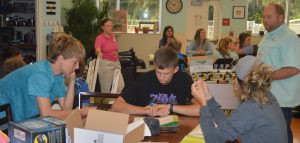 eek, 4-H’ers participate in 4 H National Youth Science Day (NYSD), the world’s largest youth-led science experiment. This year’s 4 H NYSD event will take place on October 4. The 2017 4‑H National Youth Science Day Challenge is called Incredible Wearables! This year’s challenge was developed by University of Nebraska-Lincoln and incorporates the fast-evolving field of wearable technology, teaching kids to not only use technology but to create it and understand how it works.
eek, 4-H’ers participate in 4 H National Youth Science Day (NYSD), the world’s largest youth-led science experiment. This year’s 4 H NYSD event will take place on October 4. The 2017 4‑H National Youth Science Day Challenge is called Incredible Wearables! This year’s challenge was developed by University of Nebraska-Lincoln and incorporates the fast-evolving field of wearable technology, teaching kids to not only use technology but to create it and understand how it works.
From watches and eyewear to fashion and virtual reality headsets, wearable technologies are fast becoming the must-have accessory for forward-thinking people around the world. Wearable technologies didn’t start out as trendy however – one of the world’s first wearable technologies was the hearing aid! Wearable technologies are now used in industries around the globe, from education and sports, to health, fashion, entertainment, transportation and communication. In this year’s challenge, youth use the engineering design process to build a prototype wearable technology that will gather data to help solve a real-world problem. They will design and build their own low-cost wearable health monitor following the engineering design process. This process includes defining the problem, designing and building prototypes (solutions) then systematically testing and evaluating enabling them to redesign for optimization of wearability and functionality.
During the innovative, hands-on project, these future engineers must work together to design, build and refine a wearable health-tracking device that is easy-to-use and aesthetically appealing. In fact, youth from Bay County have been training with their adult leaders to teach this challenge to other youth in their community on National Youth Science Day. Jason Scott, from Scott Innovative Solutions and an engineer at NSA PC, teamed up with the Bay County 4-H Agent to teach youth and adult partner teams about this project enabling them to be able to share their knowledge with others on October 4. When participants will attempt to solve the problem of people not staying active enough to lead healthy lives. In fact, youth will build a prototype fitness tracking device that could ultimately be marketed and sold to consumers to positively affect fitness behaviors.
After completing the challenge youth will have had an experience of using the engineering design process to build a device to help them monitor their health so they can gather data to make better decisions. They will understand more about how wearable technologies like FitBits, Smartwatches and other wearable devices are made.
The field of wearable technologies continues to grow in both quantity and quality. New technologies are being developed and put on the market on a regular basis, including virtual reality and augmented reality devices, clothing and accessories, as well as health monitoring devices. The future of wearable technologies is limited only by the imaginations of those designing them. By studying STEM and participating in this National Youth Science Day Experiment, youth could use technologies to develop products and mechanisms we haven’t even thought of, but definitely desire! To find out more information about other 4-H programs like this or volunteer your time to work with youth, contact your local UF IFAS County Extension Office or visit http://florida4h.org.
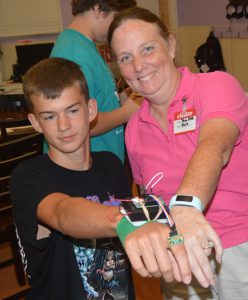
Comparing device to prototype
by Julie Pigott Dillard | Oct 3, 2017

Youth should run the business portion, which should be only 1/4 of the meeting time
The very word meeting makes me sigh and roll my eyes. I’ve been to so many that are a waste of time and energy and, let’s face it, boring! Are they ever really productive? Can’t they (please) be more interesting?
Meeting is just another word for get-together, assembly, encounter, engagement, rally or reunion. When 4-H Clubs follow the club meeting model, meetings can actually be fun! The 4-H Club meeting has three distinct parts: business, recreation and educational program. Business should take up 25% of the agenda, the educational program 50% and recreation 25% of your meeting time. The order of your 4-H Club meeting isn’t set in stone; club officers and leaders can be creative in how they set up the agenda for each club meeting.
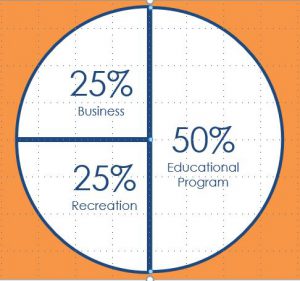 Dysfunction #1 – Adults Lead the Business Meeting
Dysfunction #1 – Adults Lead the Business Meeting
There’s no way around it; 4-H Clubs have business that needs to be dealt with including roll call, secretary and treasurer reports, committee reports, old and new business and announcements. It’s tempting for club leaders to take over and do this part of the meeting, but our youth learn nothing from this! Some of the most useful skills youth develop come from getting ready for the actual meeting and leading their peers in an organized setting, and as an adult, it’s really cool to see youth get things done efficiently. It’s also important to remember that business doesn’t have to be conducted at every 4-H Club meeting.
Dysfunction #2 – Skimping on the Educational Program
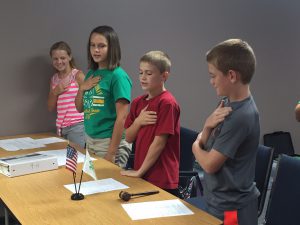
For clubs with younger youth, you can have them lead the pledges.
I’ve seen 4-H Club meetings that were literally 15 minutes long and consisted of only running through a business meeting. It made me cringe, and I know that 4-H parents were thinking the same thing as me… “Did I really leave my house for this?” “I could be sitting at my house in my PJ’s.” “I have three loads of laundry I should be folding.” “Is this all? It took me more time to drive here!” The educational program is the most important part of our 4-H Club meetings! After all, 4-H is in the business of providing high-quality educational experiences for its members, and those experiences can be pretty easy to pull together. Here are a few examples:
- 4-H Club members share what they’re doing with their projects.
- Invite a guest speaker.
- Take a short field trip.
- Show a video.
- Practice for judging contests or do a skill-a-thon.
- Create a fair project.
- Work on a community service project.
Dysfunction #3 – Forgetting the Fun
My co-worker, John Lilly, has a tag line on his email signature – Jefferson County 4-H is the place where there’s fun in learning and learning in fun! I firmly believe that the club that plays together stays together. Why? Because kids are going to want to come back, volunteers are going to stay engaged and most importantly, the parents will bring their kids back. Recreation helps kids make new friends and learn important social skills. Whether it’s through songs, ice-breakers, games, team-building activities or food, don’t forget to inject fun into 4-H meetings.
As a club member, leader or parent, you can help your 4-H Club avoid these three dysfunctions. Good 4-H Club meetings help youth make new friends, develop social skills, increase confidence and leadership and make decisions. To learn more about 4-H Club meetings, visit the florida4h.org and explore our Volunteer Training Series. The information here is great for club leaders but also for youth leaders and parents.










